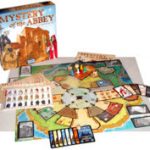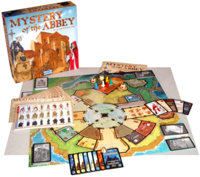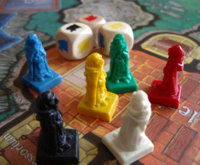On Mystery of the Abbey

Bruno Faidutti begins with the controversial premise that "[e]very game tells a story," in his description of how he uses literary techniques to enhance gameplay - even in non-RPG systems such as board games, which don't traditionally include a story.
Every game tells a story, even the most abstract one. A game of chess or Go has a beginning, a development, an intrigue, characters and reversals, and a denouement, and can be retold as such. An abstract story, however, doesn’t speak to one’s imagination, and that’s probably why I’ve always favored strongly themed games and still consider role-playing games - and specifically live action role-playing games (LARPs), which capture the theatrical essence of role-playing games - as the only real games, and all other kinds of games, be they abstract games, computer games, or board games, as merely substitutes.
The fact is, however, that I don’t have the time and energy any longer to indulge in writing LARP scenarios and organizing such big events - and that I’m becoming a bit of a lazy homebody. That’s probably why I’ve given up live-action role-playing, after about ten years of intensive practice, and moved to the calmer and smoother universe of board games. My LARP gamer history, however, as well as my interest in literature, is probably the reason why I try to give a strong theme to all my games and to have them tell something that feels like a story, something you can retell when the game is over - something you can dream of.
I always keep in mind when designing a game that it must have a kind of “story arc” (I hope I’ve understood this idea, since there’s no equivalent for “story arc” in the French language), a thread that will both help players place themselves in the game, know where and when they are, and create some growing tension, some apprehension of what will happen later. A real story, in an evocative historical or fantasy setting, is one of the most efficient ways to suggest this story arc and the one I usually use when I design a game, but it’s not the only one available since you can easily retell a game of chess or Go with the same tension and suspense as a whodunit.
Mystery of the Abbey is a whodunit board game for three to six players. It is derived from Clue, but is a kind of more fun, wild, and chaotic Clue. The setting is the abbey from Umberto Eco’s The Name of the Rose, and players move about the abbey trying to find out who killed Brother Adelmo - which in game terms means determining which one of twenty-four suspect cards is missing (placed under the board at the start of the game, without any player looking at it). Step by step, or rather, mass after mass, players get clues about the murderer: Is he a father, a brother or a novice? A Franciscan, a Benedictine, or a Templar? In the original version of the game, the third order was the Dominicans, and the French edition uses the Hospitallers. (See sidebar.) Clues can be found by asking other players about the suspect cards in their hands, or using the special abilities of the different buildings in the abbey.
The first version of what would later become Mystery of the Abbey was a science fiction game, The Red Creature with One Eye and Eight Tentacles. The story was a kind of second-degree whodunit, all about finding out which creature was missing from the space station by asking players about the number of one-eyed, three-tentacled, or green creature cards in their hand. It was fun, but a bit of a brain burner, A “brain burner” is a game that requires such deep strategic thinking that the theme, and sometimes the fun of the game, is forgotten. and the theme was not really suggestive. When Serge Laget and I decided to use this base system for a Name of the Rose game, it meant more than changing the setting, and it brought many new rules and elements to the game.
The rule stating that you can make a vow of silence (refuse to answer a question posed by another player) has a strong effect on the game and strongly contributes to the monastic ambiance. This is more allusion - in French we say a “wink” - than simulation. When someone states that he has made such a vow, you know you are in a monastery - even though it has nothing to do with the monastic orders used in the game, and even though in the real world you usually don’t make such a vow for just a few hours.
It is the same with the masses that regulate the game. Every four turns, players are called to mass and their pawns gather in the abbey church. Players pass cards to their neighbors during the mass, suggesting the talking and whispering of monks at this occasion. Also, there is always some unexpected event occurring at the end of the mass - suggested by drawing an event card. Laget and I wanted action cards, and calling them “books” was an obvious move.
This shows clearly that there is no “first” and “second” between game systems and game setting, but that when the design flows well, as I like it to flow, systems and theme regularly generate each other in a dialectic process. Sometimes, a mechanism can induce a theme (a whodunit game where you look for the culprit can be set in the Cadfael/Name of the Rose universe); sometimes the setting suggests a mechanism (if it’s a monastery, there must be a rule about silence, and there must be masses). Meddling with Monks - When he painted the monk figures, Emmanuel Roudier took his inspiration from the character cards in the first edition of the game, and from a few monk figures he found here and there in his books. He made gray monks, brown ones, and white and black ones (the latter supposedly Dominicans, although they usually dress in plain white). Afraid that there could be confusion between the gray monks and the white ones, the publisher decided to change the white and black to white and red - easy to do with Photoshop. (The red monks indeed look nicer and are easy to distinguish from the others.) When I received the first files, I was shocked. I immediately protested that red Dominicans were something really strange and would not look serious, and asked to make them plain white. I was answered that they looked nicer in red (that’s true) and that Days of Wonder’s first market was American families, who don’t care about the color of Dominican robes, since they have absolutely no idea about it, if they have ever even heard of Dominicans. We had long phone and e-mail arguments about it, until I suggested a compromise: we keep the red monks, but we name them Hospitallers. Hospitallers are supposed to be in white, with a red Hospitaller cross, and are often figured in war costume. They were not only fighting monks, in fact some of their monasteries indeed used to provide food and shelter to pilgrims. I thought everything was okay, until someone found out that the same American families (see above) didn’t know about Hospitallers and might think that the game had something to do with hospitals and medicine… . So we now have Hospitallers in the French version, and Templars in the American one! This is a fun story, but I think it shows well the concern we all, designers and publishers, have both for the technical playability of the game and for its ability to generate the feeling of a story, a feeling that needs nothing in the game that will feel “out of place” to players and could destroy the magic - like the paratroopers’ base in the Balearics in El Grande.
The idea was to suggest both Clue and The Name of the Rose, so there had to be rooms, there had to be a murder, and there had to be monks. Our rooms not only have different names, but also different effects, selected both to be useful in the game and to suggest the story. A problem with Clue is that you can play Miss Scarlet without knowing that Miss Scarlet is the murderer, and we took care to avoid such incoherencies. To differentiate the monks, rank and order sounded obvious, and combining those with a physical aspect gave a strong whodunit feel to the questions asked: “Have you seen a fat, bearded Benedictine…” Now you are in a whodunit.
References: Literature
Eco, Umberto (translated by William Weaver) (1983). The Name of the Rose. Orlando: Harcourt Books.
References: Games
Mystery of the Abbey. Bruno Faidutti and Serge Laget; Days of Wonder. 2003.
Cite this article
Faidutti, Bruno. "On Mystery of the Abbey" Electronic Book Review, 25 January 2008, https://electronicbookreview.com/publications/on-mystery-of-the-abbey/

